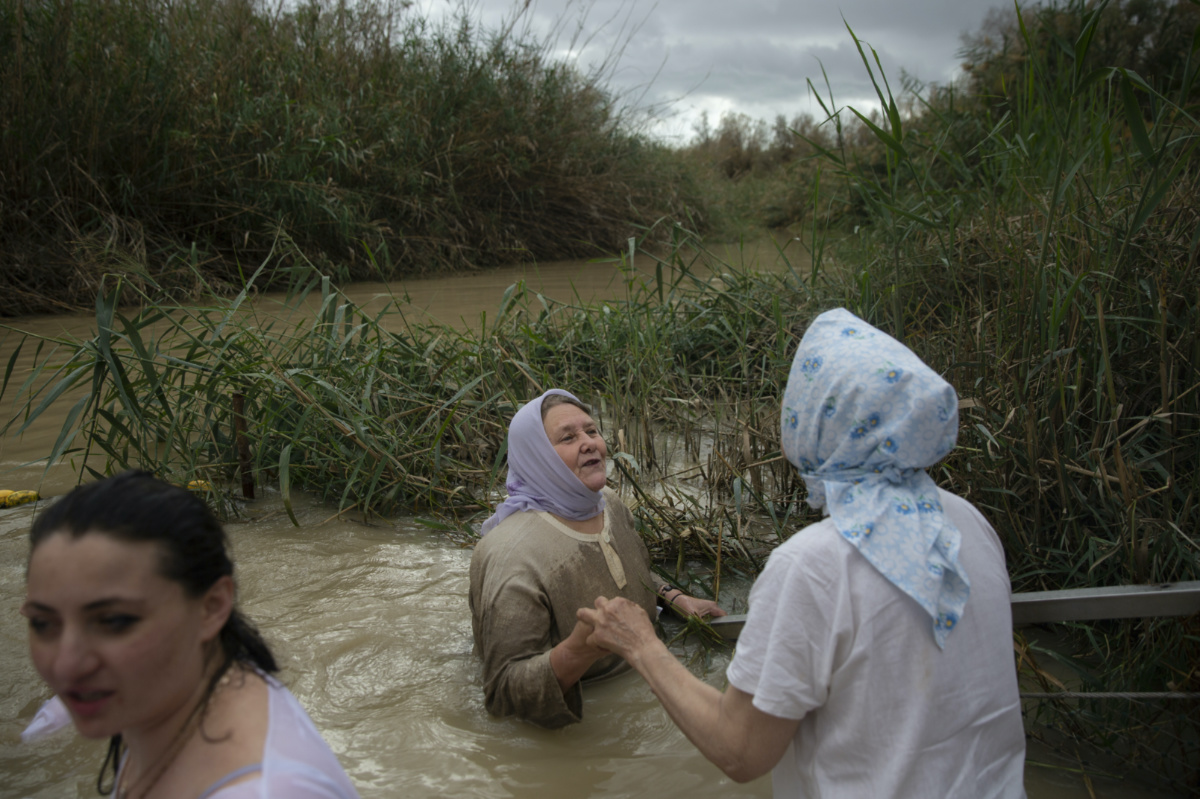
MARIAM FAM, of Associated Press, reports on concerns over the decline of the river in which Jesus was baptised…
Along the Jordan River
AP
Kristen Burckhartt felt overwhelmed. She needed time to reflect, to let it sink in that she had just briefly soaked her feet in the water where Jesus is said to have been baptised, in the Jordan River.
“It’s very profound,” said the 53-year-old visitor from Indiana. “I have not ever walked where Jesus walked, for one thing.”

Christian pilgrims stand in the waters of the Jordan River during a baptism ceremony as part of the Orthodox Feast of the Epiphany at the Qasr al-Yahud baptismal site, near the West Bank town of Jericho, on Friday, 19th January, 2018. Tourists and pilgrims come to the river from near and far, many driven by faith, to follow in Christ’s footsteps, to touch its water, to conjure up Biblical events. PICTURE: AP Photo/Oded Balilty.
Tourists and pilgrims come to the site from near and far, many driven by faith, to follow in Christ’s footsteps, to touch the river’s water, to connect with Biblical events.
Symbolically and spiritually, the river is of mighty significance to many. Physically, the Lower Jordan River of today is a lot more meager than mighty.
“It’s a victim of the conflict, definitely. It’s a victim of people, because it’s what we did as people to the river, basically, and now adding to all this it’s a victim of climate change. So it’s a victim in every way.”
– Yana Abu Taleb, the Jordanian director of EcoPeace Middle East.
By the time it reaches the baptismal site, its dwindling water looks sluggish, a dull brownish green shade.
Its decline, due to a confluence of factors, is intertwined with the entanglements of the decades-old Arab-Israeli conflict and rivalry over precious water in a valley where so much is contested. Championing the transboundary Jordan’s revival without wading into the thicket of the disputes that have fueled its deterioration can be a challenge.
A stretch of the river, for instance, was a hostile frontier between once-warring Israel and Jordan; river water also separates Jordan on its eastern bank from the Israeli-occupied West Bank, seized by Israel in a 1967 war and sought by the Palestinians for a state.
“It’s a victim of the conflict, definitely. It’s a victim of people, because it’s what we did as people to the river, basically, and now adding to all this it’s a victim of climate change,” said Yana Abu Taleb, the Jordanian director of EcoPeace Middle East, which brings together Jordanian, Palestinian and Israeli environmentalists and lobbies for regional collaboration on saving the river. “So it’s a victim in every way.”
EcoPeace has said for years that the Lower Jordan River, which runs south from the Sea of Galilee, is particularly threatened by decades of water diversions for agriculture and domestic use and by pollution. Only a tiny fraction of its historical water flow now reaches its terminus in the Dead Sea, not far south from the baptismal site that Burckhartt visited.
That’s one reason the Dead Sea has been shrinking.
Standing at the Jordanian baptismal site Bethany Beyond the Jordan, Burckhartt, a Presbyterian, said the river’s water felt cold on her skin, offering a respite from the sweltering heat around her. In the jumble of emotions, she grappled with, she could also feel sadness for the river’s dwindling.
“I am sure God above is also sad.”
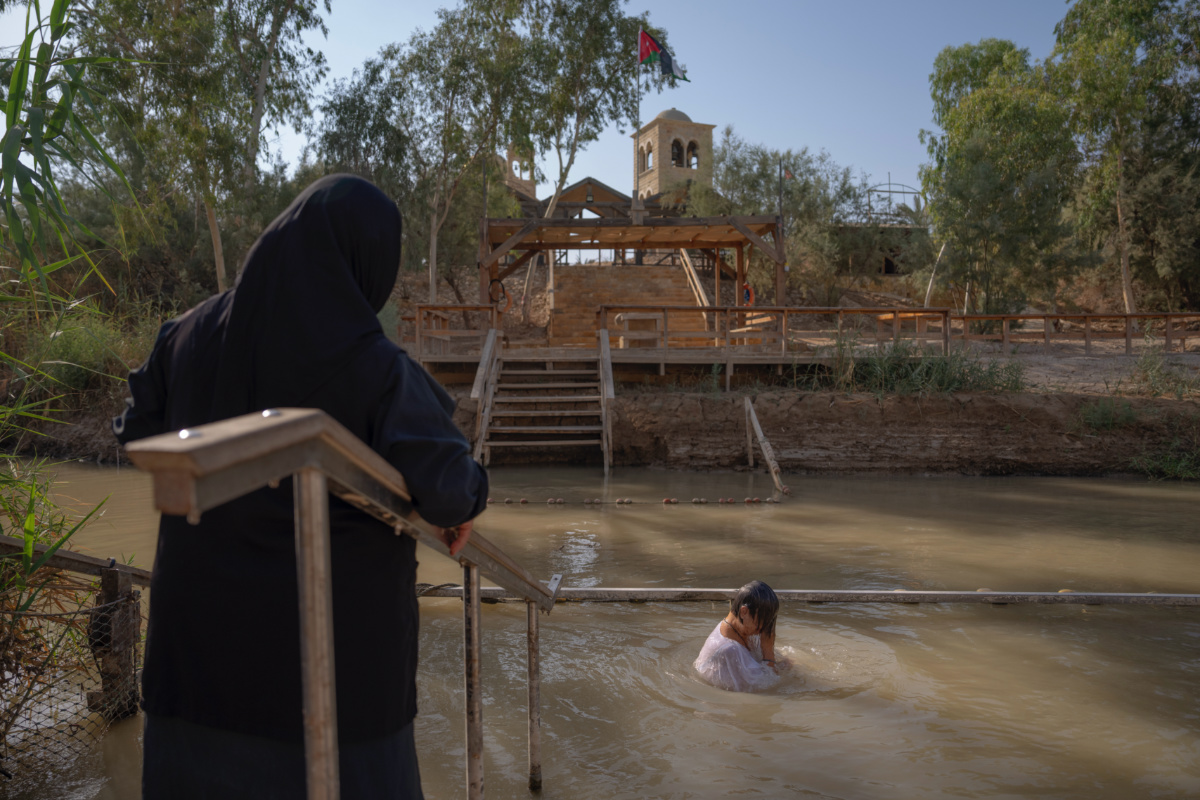
Olga Bokkas, a visitor from Connecticut, immerses herself in the waters of the Jordan River at the Qasr al-Yahud baptismal site, near the West Bank town of Jericho on Sunday, 31st July, 2022. The river’s dwindling waters are sluggish and a dull brownish green in this area. PICTURE: AP Photo/Oded Balilty.
The Bible says Jesus was baptised in the Jordan River.
The river’s eastern bank, modern-day Jordan, and its western one both house baptismal sites, where rituals of faith unfold, a reflection of the river’s enduring religious, historical and cultural allure.
The river holds further significance as the scene of miracles in the Old Testament; after years of wandering the desert, the ancient Israelites are said to have crossed the Jordan on dry ground after the water was stopped for them to pass.
At the Jordanian baptismal site on the eastern bank recently, a woman dipped her feet in the waters and then cupped some with her hands, rubbing it on her face and over her head. Others touched the river and crossed themselves or bent over to fill empty bottles.
Charlie Watts, a tourist from England, submerged a wooden cross – a gift and a blessing for his Christian mother back home. “I took a video…so I can show her that it was true,” Watts said.
While he is not as religious as his mother, the 24-year-old still considered his visit to the Jordanian site special: “What made it surreal is to think that this is what started the world movement of Christianity.”
In an interview, Rustom Mkhjian, director general of the Baptism Site Commission in Jordan, spoke passionately about the Jordanian site’s claim to authenticity and its preservation as it was in the time of Christ and John the Baptist. UNESCO has declared it a World Heritage Site “of immense religious significance to the majority of denominations of Christian faith, who have accepted this site as the location where Jesus” was baptised.
“Every year we celebrate interfaith harmony, and among my happiest days in my life is days when I see Jews, Christians and Muslims visit the site and the three of them cry,” Mkhjian said. “The present spot where we are is a site with a great message needed: Let us build human bridges of love and peace.”
The Jordanian and West Bank sites both give visitors access to the river, where they come face to face, a narrow stretch of the waterbody between them. An Israel flag at the West Bank’s Qasr al-Yahud serves as a reminder to those in Jordan that the river is a frontier separating the two worlds.
That site is also billed as where, according to tradition, Jesus was baptised. Jordan and Israel compete for these people’s tourism dollars.
Several people in flowing white robes waded in from the West Bank recently, posing in a semicircle for photos. Visitors in another group stood on riverbank steps or in the water itself as two men in black, apparently clerical attire poured river water over their heads.
In the background some sang, their voices heard back on the Jordanian side: “Oh, Brothers, let’s go down…Down in the river to pray.”
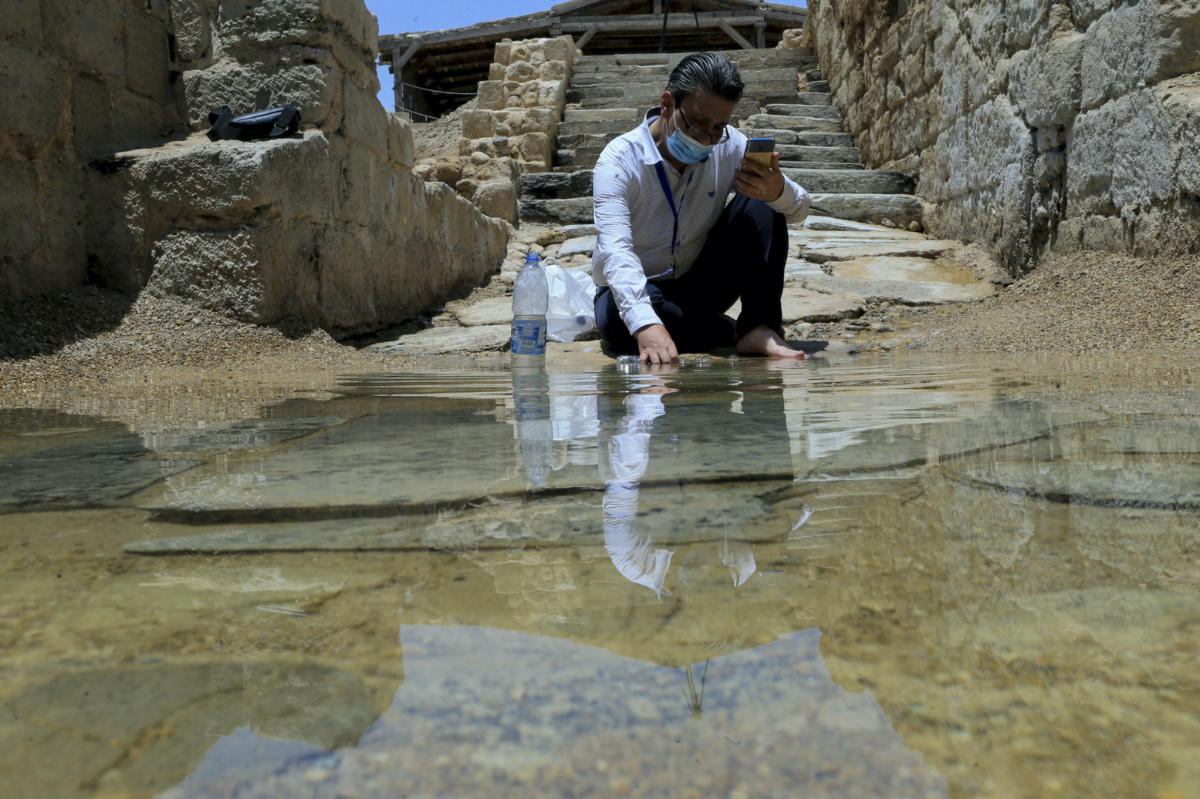
Syrian Christian Zuhair Al-Sahawi immerses his hand in water at the Bethany Beyond the Jordan baptismal site on the east bank of the Jordan River in Jordan on on Wednesday, 8th June. PICTURE: AP Photo/Raad Adayleh.
Such serene moments contrast with the military hostilities that have played out on the river’s banks as part of the Arab-Israeli conflict. The river’s history and its water have been as politically fraught as holy, and for decades land mines have lurked menacingly on banks that were once a war zone.
On the eastern bank, demining of the area where the Jordanian baptismal site now sits began after a 1994 peace treaty between Jordan and Israel.
On the West Bank, a team from The HALO Trust, a British-American charity, has cleared mines from areas housing churches in the vicinity of the Qasr al-Yahud site as recently as 2020. The site itself had opened for the public years earlier after Israel cleared a narrow road to the river, while the churches area remained off-limits and frozen in time for decades.
Work began to clear those mines in 2018, but only after three years of building trust and getting onboard all involved, from Israeli and Palestinian authorities to several Christian denominations that own the churches and lands, said Ronen Shimoni, who was part of the HALO effort.
We rely on our readers to fund Sight's work - become a financial supporter today!
For more information, head to our Subscriber's page.
It’s against that turbulent backdrop that EcoPeace Middle East has been urging regional collaboration on the Jordan between rivals who have long had every motivation to squeeze as much water as possible out of the river or its tributaries.
“Any fresh water left in the river would have in the past been seen as empowering the enemy…You take everything that you can,” said Gidon Bromberg, the group’s Israeli director.
“There’s legitimate need for the water…Water is scarce,” he said. “But the conflict creates an incentive to take everything.”
The result is that the Lower Jordan’s annual discharge into the Dead Sea was estimated at 20 million to 200 million cubic meters compared to a historic amount of 1.3 billion cubic metres, according to a report published in 2013 by a UN commission and a German federal institute. Bromberg puts the current figure at no more than 70 million cubic metres.
“Israel, from a historical perspective, has taken about half the water, and Syria and Jordan have taken the other half,” Bromberg said. “The pollution that’s coming into the river is coming from Jordanian, Palestinian and Israeli sides and a little bit also from Syria.”
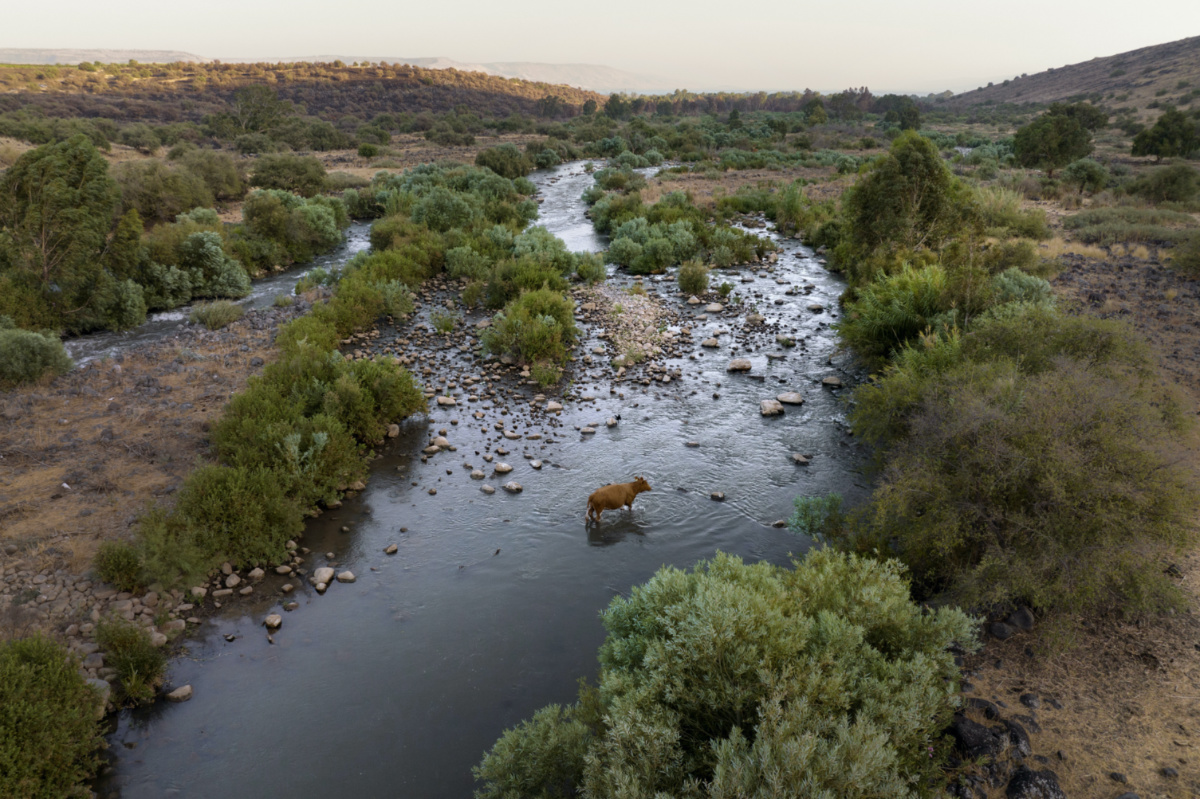
A cow crosses the Jordan River near Kibbutz Karkom in northern Israel on Saturday, 30th July. PICTURE: AP Photo/Oded Balilty.
Water use in the Jordan River basin is unevenly developed, the UN-German report said, adding that the Palestinians can no longer access or use water from the Jordan River itself. Syria doesn’t have access to the river but has built dams in the Yarmouk River sub-basin, which is part of the Jordan River basin, it said.
For Palestinians in the West Bank, the only way to see the Jordan River is to visit the Israeli-run baptismal site there, said Nada Majdalani, EcoPeace’s Palestinian director.
“The Jordan River in the past, for Palestinians, meant livelihoods and economic stability and growth,” she said. Now, she added, it has been reduced to an “ambition of statehood and sovereignty over water resources.”
The river’s decline, she said, is especially disappointing to elderly Palestinians “who remember how the river looked … and how they used to go fishing, how they used to have a dip in the river.”
Bromberg said EcoPeace has been documenting the “lose-lose” nature of the river’s deterioration for all parties.
“From a Jewish tradition, you know, the river and its banks are a place of miracles,” he said. “Well, it doesn’t reflect a place of miracles in its current depleted state.”
In late July the Israeli Government approved plans to rehabilitate a stretch of the Lower Jordan, a decision described by Environmental Protection Minister Tamar Zandberg as “historic” and the beginning of a correction.
“For decades it was neglected and most of its waters were taken, and it effectively turned into a sewage canal,” Zandberg said in a statement. “In an era of climate crisis and a serious ecological crisis, there is double significance to rehabilitating the River Jordan and returning it to nature, the public, and hikers.”
Speaking by phone, Zandberg said the plan focuses on a stretch that runs in Israeli territory and reflects Israel’s improved water situation given its desalination program, which has left it much less reliant on water it has been using from the Sea of Galilee.
“Now, we’re actually more equipped to do it,” she said. “We have water.”
She added she hopes the decision would showcase the river’s potential and pave the way for broader collaboration on the rest of the Lower Jordan as well as send a signal to Jordan that “we are committed…to our mutual assets,” including the river.
“It can provide a success story on that segment, and then it will enable more successful partnerships in the future.”
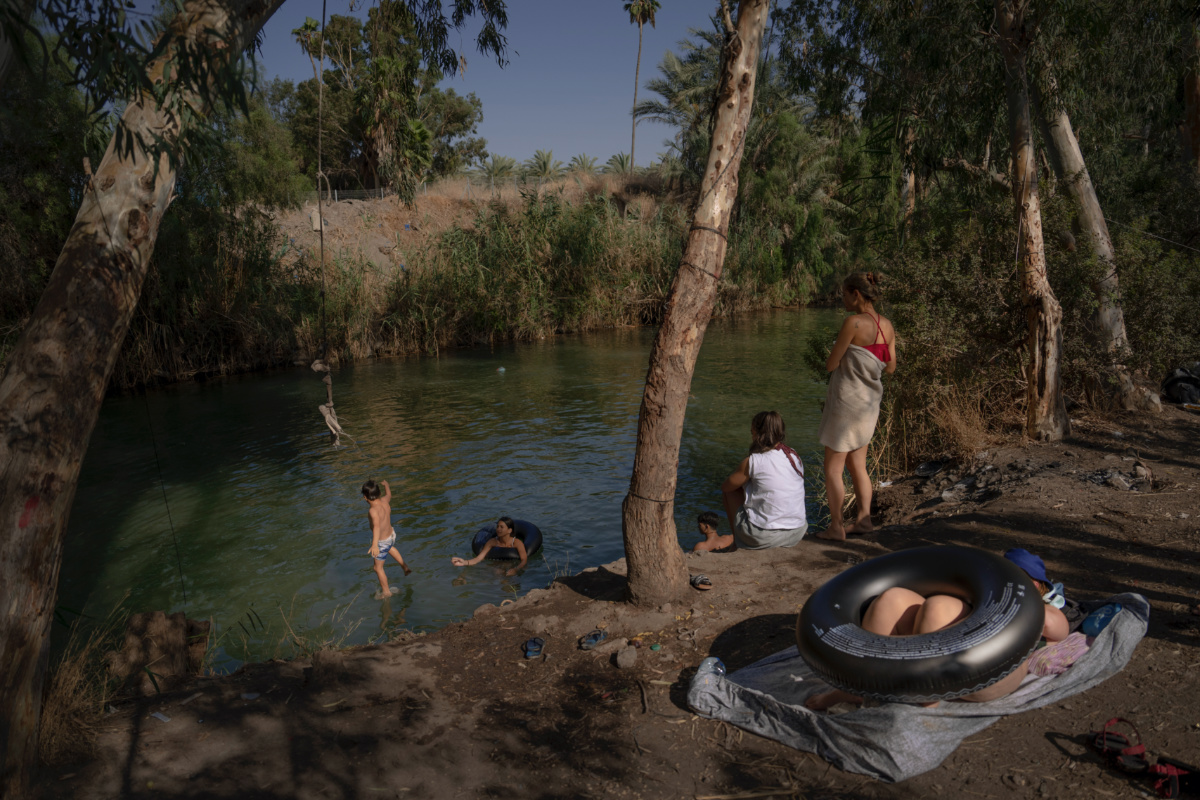
People spend the day at the Jordan River near Kibbutz Kinneret in northern Israel on Saturday, 30th July. Environmental group EcoPeace Middle East has been urging regional collaboration on the Jordan between rivals who have long had every motivation to squeeze as much water as possible out of the river or its tributaries. PICTURE: AP Photo/Oded Balilty.
That’s something that hasn’t always come easily.
“Politics, sometimes, interferes and also budget issues and the trust…between the parties,” Zandberg said.
A regional rehabilitation and development master plan announced in 2015 by EcoPeace and others was adopted by the Jordanian government but not by the Israelis or Palestinians due to outstanding “final-status” peace process issues, according to the group.
That plan said the lower part of the Jordan River will require at least 400 million cubic metres of freshwater per year to reach “an acceptable rehabilitation level”.
Creation of a trust fund to finance de-pollution projects – an effort that EcoPeace had viewed as less politically controversial – stalled after a 2017 diplomatic crisis between Israel and Jordan and amid years of strained ties under the government of former Israeli Prime Minister Benjamin Netanyahu. There have been signs of improved ties since.
Not everyone in the region welcomes, or trusts, EcoPeace’s calls for cooperation.
“Our job is tough. Our messages are challenged,” said Abu Taleb, the group’s Jordanian director.
“Because of having that, you know, Israeli chapter, we’re always accused of being ‘normalizers,’” or having normal relations with Israel, Abu Taleb said. That is a contentious topic, unpopular among many ordinary Arabs, citing factors such as Israel’s open-ended occupation of lands it captured in 1967 and a lack of a resolution to the Palestinian issue. “The water knows no borders,” Abu Taleb said.
Bromberg said he, too, has run into criticism from what he said was a vocal minority in Israel “inappropriately” branding their work as benefiting Jordanians and Palestinians at the expense of Israeli interests. “Sadly, there are people who think that if you’re working with the other side, you must be working for the other side exclusively,” he said.
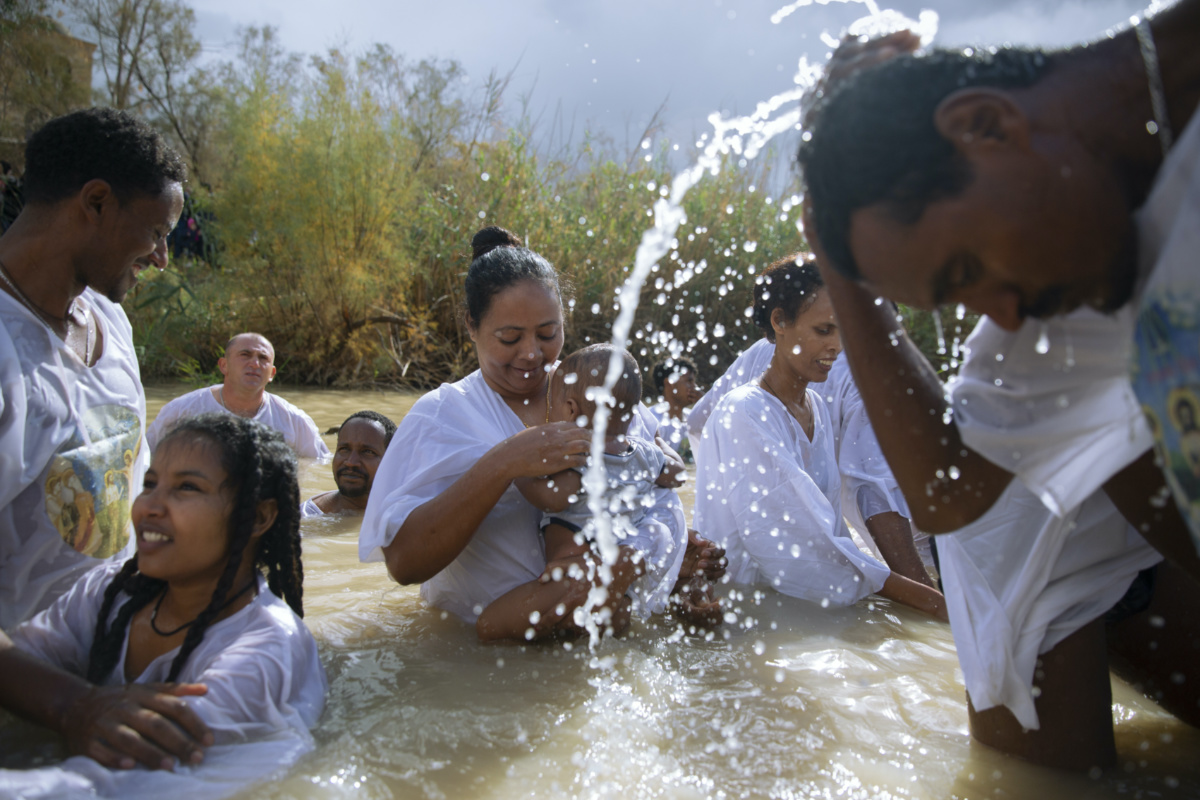
Members of the Eritrean and Ethiopian Christian Orthodox community from Tel Aviv participate in a baptismal ceremony in the waters of the Jordan River as part of the Orthodox Feast of the Epiphany at the Qasr al-Yahud baptismal site, near the West Bank town of Jericho on Friday, 19th January, 2018. PICTURE: AP Photo/Oded Balilty.
Politics aside, the strain on some governments to meet water needs complicates calls to add water to the river.
Jordan, for instance, is one of the world’s most water-scarce nations, and its challenges are compounded by a growing population swelled by waves of refugees.
“We are under stress, so we don’t have a surplus to add to the Jordan River and to revive it despite the great importance of this to the Jordanians,” said Khalil Al-Absi, an official with the Jordan Valley Authority.
“Solutions require concerted [regional] effort and the international community’s” help, the Jordanian official said.
“We have many beautiful ideas for the Jordan River but there are limitations.”
Climate change threatens to exacerbate such problems. “The impact of the climate change is seriously influencing the water resources,” Al-Absi said.
According to the World Bank, the Middle East and North Africa region faces the greatest expected economic losses from climate-related water scarcity, estimated at six per cent to 14 per cent of GDP by 2050.
Advocates, like Bromberg, acknowledge that climate change makes a Jordan revival harder – but argue that restoring the river and its banks offers economic incentives.
“The climate crisis brings home the issue of urgency that rehabilitating the river is perhaps the only way to prevent further instability in the valley,” Bromberg said, “because it can create alternative revenues through tourism.”
For all the river’s challenges, Al-Absi, the Jordanian official, said he remained optimistic. The alternative could be grim.
“If there is no water, people won’t come despite [the presence] of religious sites,” he said. “Water is life. Without water, there is no life.”
– FAM reported from Bethany Beyond the Jordan and Amman, Jordan; with reporting by ILAN BEN ZION in Jerusalem.






